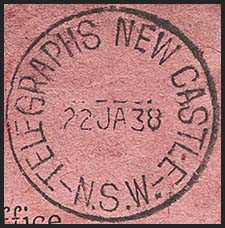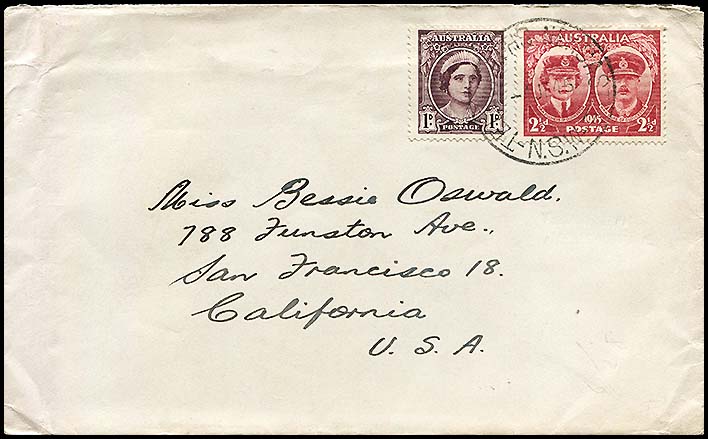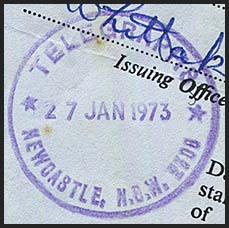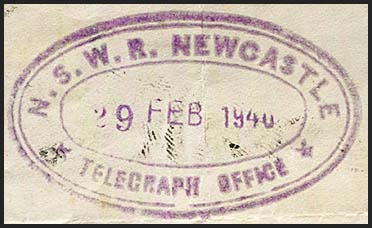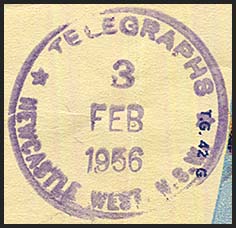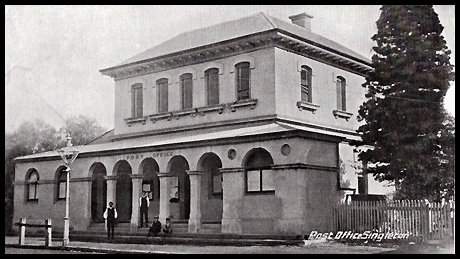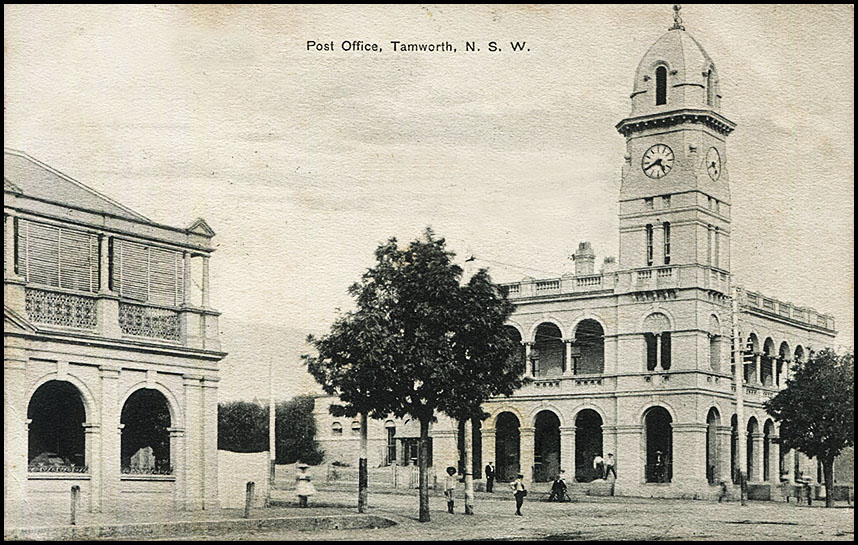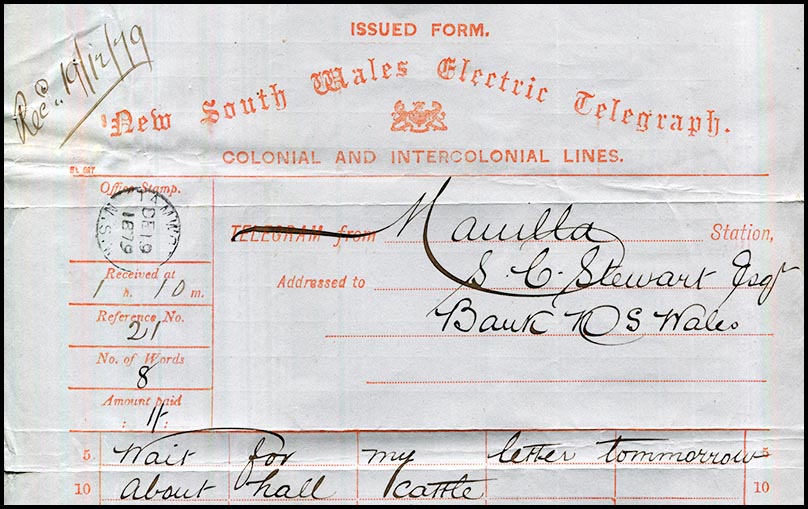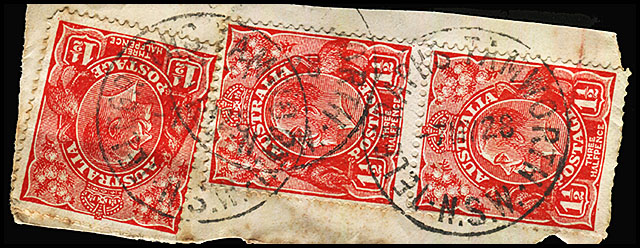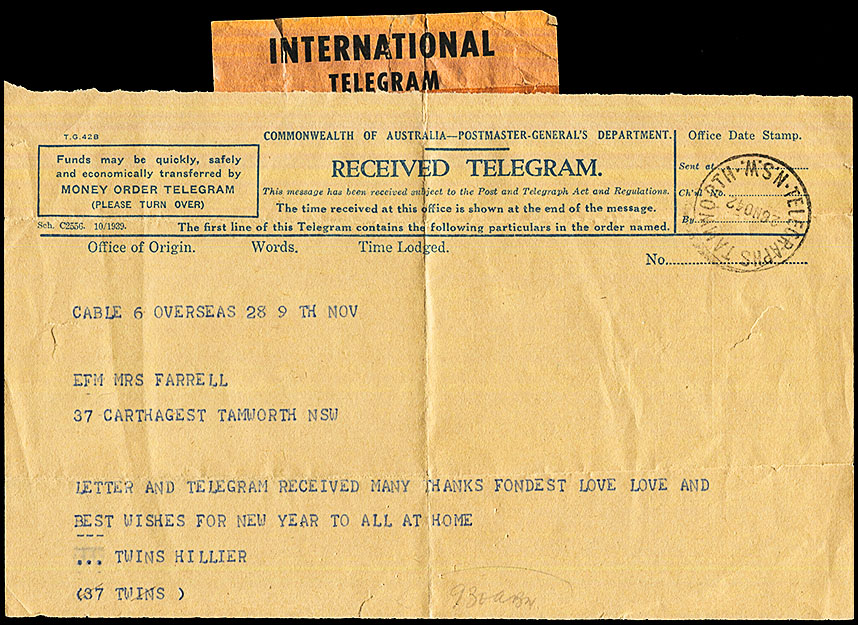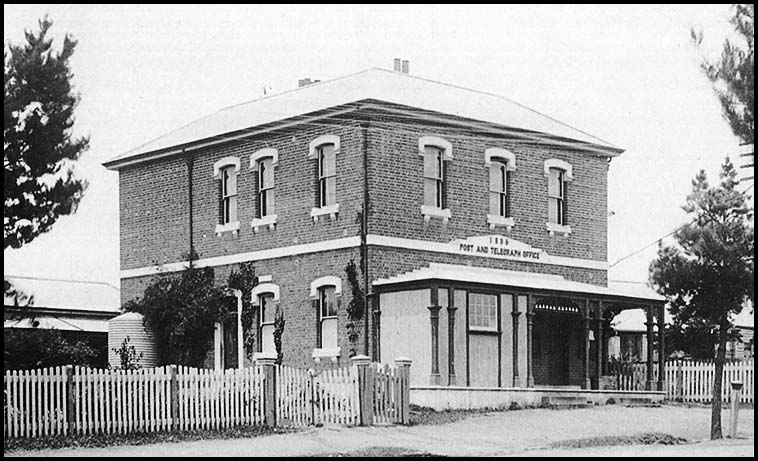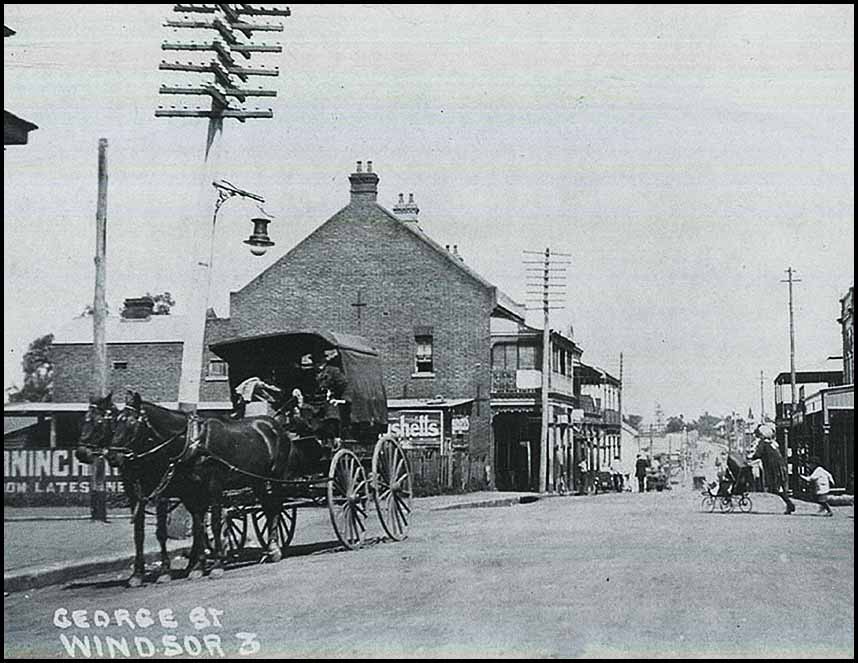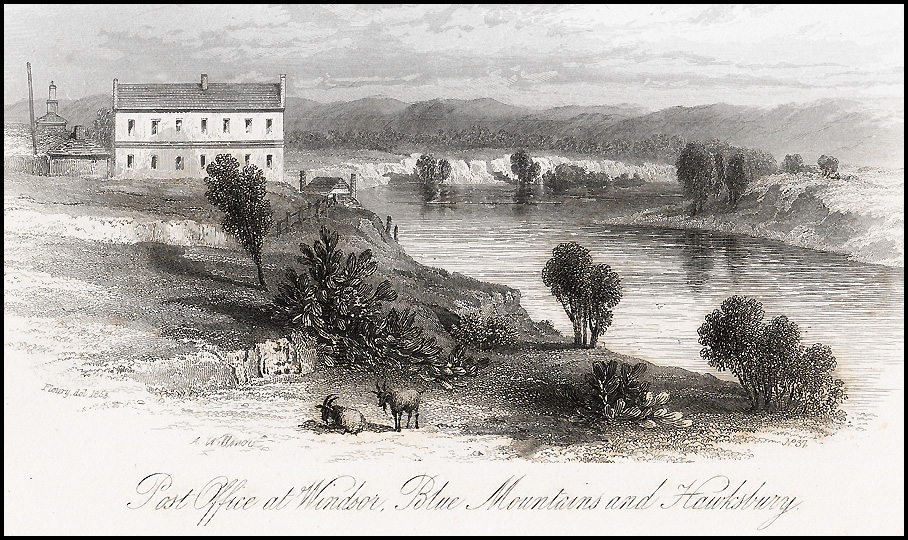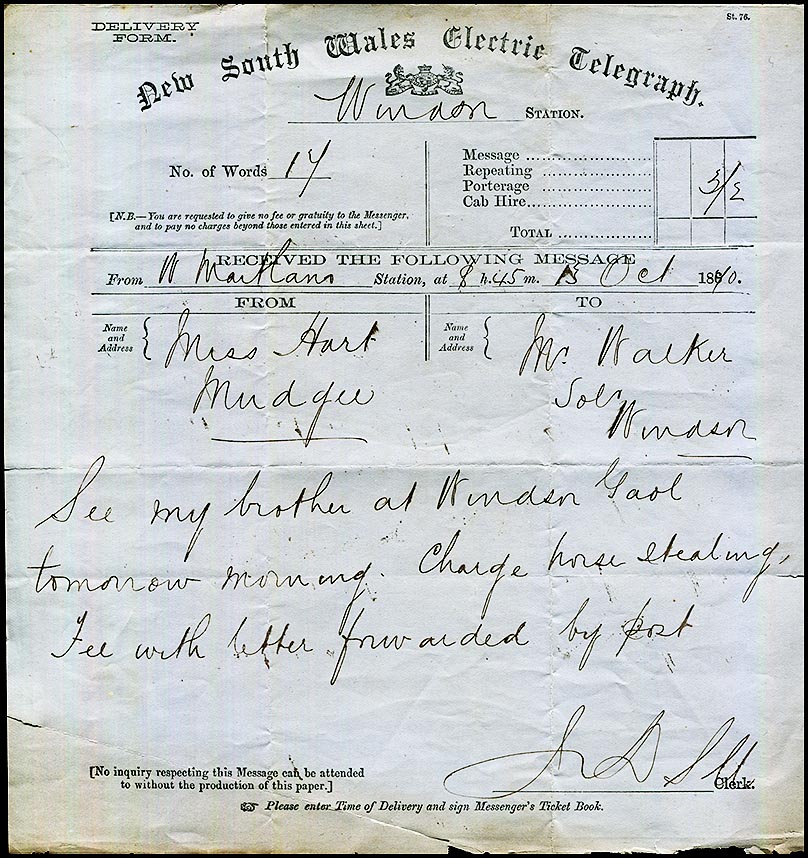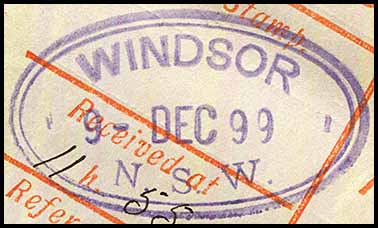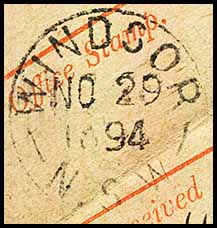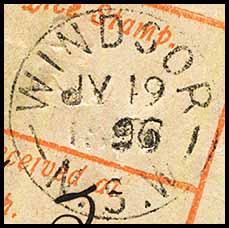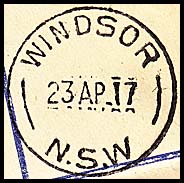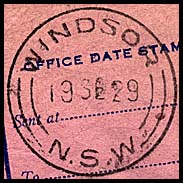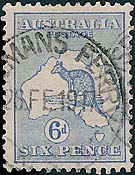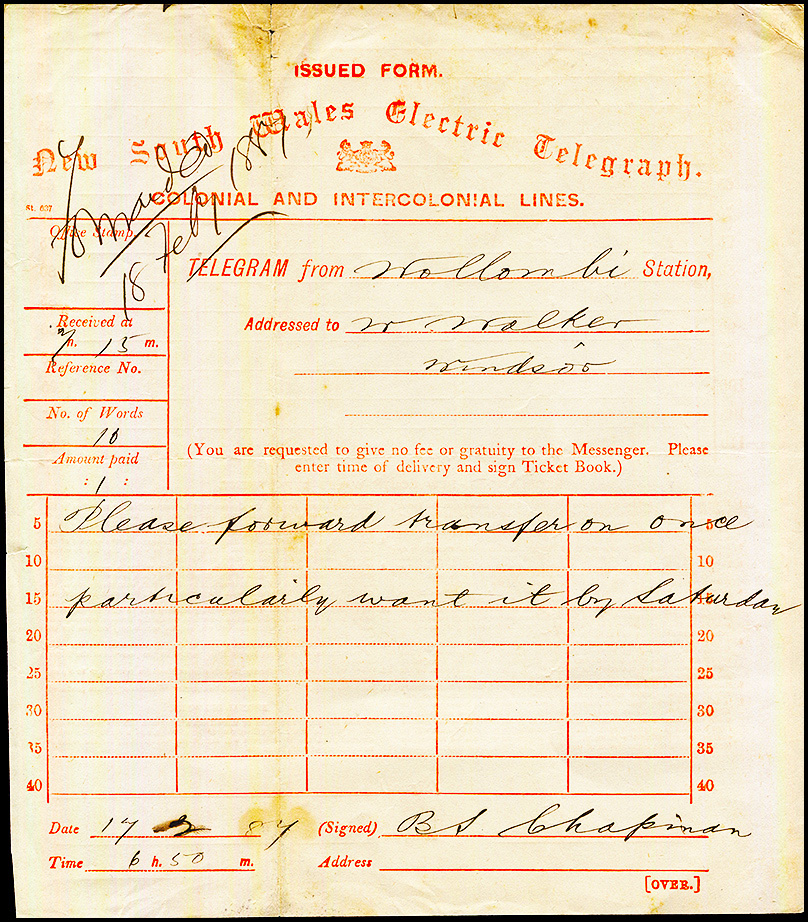P&T Offices on the Northern line to Queensland (1861).
- Australia 1901-1988
- New South Wales
- Queensland
- South Australia
- Tasmania
- Victoria
- Western Australia
- International
- Special aspects
The Telegraph Offices constructed along the first Northern line to Queensland are listed in the table below. Stations included are those during the first construction period as well as others which were added subsequently.
| Armidale.
A Telegraph Office was opened (somewhere in Armidale) on 14 October 1861. Tenders were let on 19 August 1862 to Mr Edward Grover for the erection of two buildings for the two offices. The Post Office had opened in Armidale on 1 March 1843.The Telegraph Office was not combined with the Post Office until 1 January 1889. Armidale is discussed in both the Northern Line |
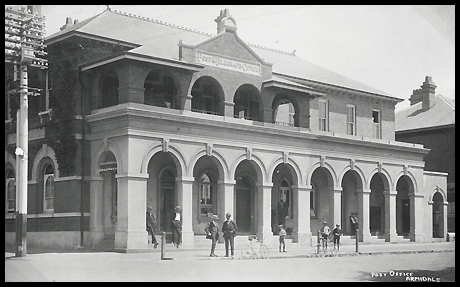 Armidale Post &Telegraph Office (about 1905). |
As developments were occurring further south which were not clear to Armidale people, "a public meeting was held at the Post Office Hotel, on the 4th instant, to consider the desirableness of petitioning for the extension of the electric telegraph to Armidale. The chair was taken by Mr. S. Cohen. Mr. Markham produced a petition, which he submitted to the meeting for approval or correction, and which, after some discussion, was adopted. The petitioners pray that "a sufficient sum may be placed on the Estimates for 1860, for the extension of the electric telegraph to Armidale by which means growers, and others of your petitioners, could avail themselves of the many benefits arising from such speedy means of communication, not only with Maitland and Sydney, but also with Bathurst, Albury and Melbourne which, under present circumstances, in the sale of stock and other commercial transactions, would materially advance the interests of the district and facilitate the business transactions which now, and must continue to exist, between the two colonies. The importance of the extension is also maintained on the ground that it would be the most direct means of connecting the Australian colonies with Europe and also from the fact that, in the event of an extension to the northern townships of Queensland, the expense of New South Wales would be limited - Armidale being so near the boundary of the two colonies. The petitioners submit further that Armidale must always be the capital of the Northern districts and that, as a similar boon to that which they solicit, has been already granted to townships of minor importance, their request ought in justice be complied with" (Express, January 1860). The Armidale Express of 7 December 1861 reported: "It has been suggested to us that, as the Armidale office is a repeating station between Brisbane and Sydney, there should be an additional assistant provided here to ensure the prompt receipt and despatch of telegrams connected with Armidale. We think favourably of the idea, as we imagine that telegraphic business between Brisbane and Sydney must at times be very extensive. Probably an application, signed by the parties mainly interested, to the Superintendent of Telegraphs would receive due consideration".
The Armidale Express of 21 July 1921 claimed that: "The Armidale telegraph office is now regarded as the most important country office in the State. It is not only the main repeating centre between Melbourne, Sydney, and-Brisbane, but occupies an important position in relation to most of the North Coast and North offices. A good illustration of this fact occurred during the recent floods. Though it meant that some of the staff had to remain at work all Saturday night and Sunday, the Armidale office was able to keep communication intact between the Northern and Southern capitals and also preserve connection between the metropolis and the North Coast". |
|
|
|
| Although there is no real connection to the telegraph, the following is an interesting comment of life "in the olden days" which sometimes has relevance to modern times - taken from the Armidale Express of 28 April 1860:
"We think we are correct in stating that during the past four years, no investigation has been held by the authorities in Armidale as to the correctness of the weights used by traders in this township. We are aware that there are standard weights in the possession of the Chief Constable but we understand that, owing to the want of scales which are stated to be scarce in the colony at present, weights in use cannot be tested. We beg to state that this is a subject which has elicited frequent complaints from the public and we hope that the Bench may take the matter up and cause scales to be obtained with as little delay as possible". and also:
Lamp posts were erected at street corners in Armidale during September 1885 to be in readiness for gas illumination. Personnel: At the time of opening the Armidale Telegraph Office, Mr. Macguire was in charge. For the opening, he "was absent for several days (accompanying Mr. E. C. Cracknell) at the more Northern stations, giving assistance to put the instruments there in proper order. During his absence Mr. Middleton, his assistant, though young, discharges the duties with zeal and efficiency".
|
|
Early usage: The earliest indications of the operation of the Armidale Telegraph Office are:
|
|
1. Armidale was one of the 29 Telegraph Offices included in the special printings of delivery envelope NC-EO-3. These envelopes incorporated an embossed oval seal (EO6-ET) on the flap of the envelope with NEW SOUTH WALES at the top and ELECTRIC TELEGRAPH at the base. The office name was embossed across the centre of the seal.
|
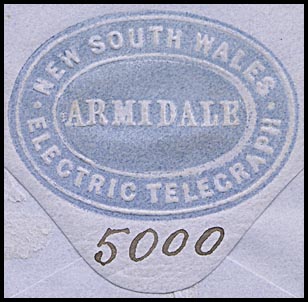 Scan of embossed oval on flap of envelope. Provenance: De La Rue Archives, Gundersen, Johnstone Collection. |
2. See details of the ELECTRIC TELEGRAPH/ARMIDALE oval date stamp and the straight line ARMIDALE below on delivery form NC-DO-10A. |
|
Telegraph Offices were also opened at:
|
|
The only TELEGRAM slogan cancellation recorded as having been used at Armidale is SEND A TELEGRAM. The only recorded example of its use is on 12 September 1939. |
Four types of hand stamps were issued to the Armidale Office for use with telegraphic work: |
|
|
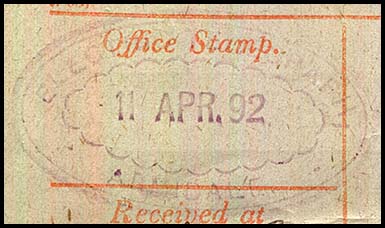 11 April 1892. Used on NC-DO-9A. |
|
|
|
|
|
The Sydney Morning Herald of 21 April 1863 reported "The telegraph office was opened to-day 20 April) for the transmission of messages. Every assistance was afforded to the station-master by the inhabitants in preparing for the opening". Two months earlier - on 7 February 1863 -- the Armidale Express had reported developments in the "construction" of a Telegraph Office: "We have much pleasure in notifying that Bendemeer will in future be enabled to participate promptly in the advantages of the electric telegraph. The thanks of the public in the Bendemeer district are due to Mr. Perry, from whom we publish the following communication: "To the Editors of the Armidale Express. Bendemeer, 30th Jan., 1863. On 28 July 1866, the Armidale Express reported the following: "A ridiculous affair occurred here the other day; our Telegraph office was actually mistaken by a poor traveller for a board and lodging house! The origin of this most absurd mistake no doubt was caused by its having been ornamented for some time past by a Lilliputian flagstaff, from the top of which floats two coloured rags and upon one of these the word "Joe" is written. Some of the inhabitants are under the impression that the Telegraph stations have all been named, and that ours rejoices under the cognomen of 'Joe.' Whilst on this subject, 1 cannot help mentioning a grave complaint made against Telegraph authorities. 1 am informed that on the 16th inst. a message was sent from Armidale at 3 p.m., and received at the office here, according to the delivery form, at 6 p.m.; and, although the person to whom it was sent lived within sight of the office — in fact, only a few hundred yards off — it was not delivered till past 9 the following morning. The hardest part of the matter was that it was a message from a son, to relieve the great mental distress of an aged mother and should therefore admit of no excuse". |
|
| On 9 December 1879, £1,000 was placed on the Estimates for 1880 for the erection of a Post and Telegraph Office at Bendemeer.
Seven years later, the advertisement at the right appeared in the Gazette and many newspapers. It had also been advertised in November 1885 and then reappeared in March 1887. |
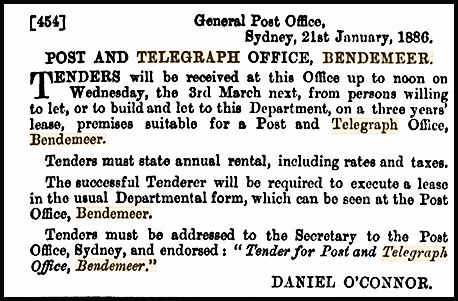 |
Personnel: April, 1864: Mr. Alexander Burnett was appointed Junior Operator. November 1868: Mr. James Carry Jnr. was appointed Junior Telegraph Operator. January 1875: Mr. Frederick Falkner, to be Telegraph Station Master at Bendemeer, vice Mr. F. Sykes. July 1876: Mr. Culnane resigned.
|
|
|
A Telegraph Office was probably established at Boonoo Boonoo - about 23 km north of Tenterfield - during 1861. As it is not listed in official records, the station was probably a Repeating station although the distance from Tenterfield was very short. A Receiving Office was not opened until 1 June 1887 and it was converted to a Post Office on 15 July 1899. |
The Courier (Brisbane) of 31 December 1861 carried the following story: "During the storm of Thursday afternoon last, the lightning struck the telegraph office, knocking Mr.Fitzroy off his stool and completely fusing the wires of the relay thereby putting a stop to all communication till a new one arrives. The report was distinctly heard by several parties at a distance. Mr. Fitzroy started yesterday morning for Armidale in order to procure a new relay, if possible, so that we cannot have telegraphic communication for eight days at the least". |
|
A Telegraph Office was opened at the Railway Station on 14 September 1909. It closed on 31 October 1961. |
|
A circular rubber date stamp (RC1-GIR) was issued to the Office.
|
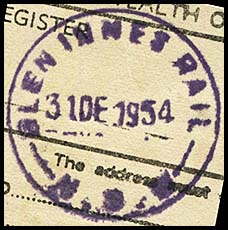 31 December 1954. |
|
The Armidale Express reported on 28 July 1885The same edition also reported that there had been no drunkards arrested in Armidale in that week. that "The residents of Guyra petitioning for the establishment of public Telegraph Office there. 2nd. Also for a Money Order Office". The Gazette announced that the Telegraph Office at Guyra opened on 7 September 1885 at the railway station. |
|
| Maitland and West Maitland.
A Post Office was opened at Maitland on 1 September 1829 and it changed name to West Maitland about 1852. The Post Office and Telegraph Office merged on 2 October 1900. The Office name reverted to Maitland on 1 April 1949, Hence the Telegraph Office opened as West Maitland on Monday 16 January 1860. The first telegram was received in Maitland from Sydney on that Monday announcing the arrival of the Eagle from Rockhampton. The line to Newcastle was not yet open because a portion of the necessary machinery had been mis-sent to Morpeth. Tenders were called in the Gazette of 13 July 1860 for the erection of an Electric Telegraph Station at West Maitland with a closing date of 24 July. A tender was accepted on 7 August and work was reported as being underway in late August. |
|
Given the rumoured developments at Newcastle, residents began asking if the Telegraph Office and the Post Office could be housed under the same roof. If that could be the case, then "no time should be lost in getting up a memorial on the subject, before the building has too far advanced. It may be well to point ont that erecting public buildings on too small a scale in such a rapidly growing town as West Maitland is shortsighted policy. When the present West Maitland court-house was being erected we repeatedly drew attention to the smallness of the building, and tbe imperfect accommodation afforded, The result proves that the "court-room" is crowded to suffocation frequently, when any case of interest is under hearing. On Monday, when the District Court was sitting, the magistrates had to hold the police court in the lock-up keeper's bedroom, with its usual furniture still in it" (Maitland Mercury 23 August 1860).
The Mercury in July 1860 reported that "fourteen offers of sites for the telegraph station, West Maitland, had been made to the Government at various prices. Yesterday we were informad that the choice has fallen on the fine piece of land next to Mr. Falkiner's, at the corner of High and Bourke Streets, one of the best and most central sites in the town. The price is said to be about £700. The Hlgh Street frontage, unless we mistake, is little more than fifty feet". On 21 August 1860, the Sydney Morning Herald noted that a tender for the construction of a "neat brick house" for the Telegraph Office had been accepted and construction had commenced. On 25 September: "During the past week the excavatlon for the foundation of the Telegraph Station at the corner of High Street and Bourke Strect was commenced, and now we may report its advancement towards completion. The building will be unpretending, but of a neat and even tasteful appearance. The site is sufficiently central. If the promise to furnish the station with a public clock, regulated by telegraph, is carried into effect, it will be of great advantage to the public". The SMH of 22 October 1860 expanded on these developments: "Several new telegraph stations are in progress or about to be proceeded with, the courthouses having hitherto been used for that purpose in the towns through which the wires have been carried. New stations have been commenced at West Maitland, Newcastle, Windsor, Albury, Goulburn, Bathurst, and Yass and others will soon be put up at Gundagai, Hartley and Wollombi. The buildings are nearly all upon one plan consisting of five rooms including a residence for the station master". Floods again ravaged the district around Maitland and beyond in August-September 1879. As an example of the role of the telegraph offices and their Station Masters and staff in times of danger and disaster, it is informative to appreciate the emotions behnd the comment published in the Maitland Mercury on 13 September 1879:
On 2 October 1900, the office was upgraded to a Post & Telegraph office. The name of the combined office reverted back to Maitland on 1 April 1949. |
|
|
|
The Maitland Mercury of 29 June 1969 reported special news: "CLOCK FOR THE TELEGRAPH OFFICE. At last, when the patience of the much-enduring Maitlanders had been exercised so long that for that one virtue they deserved to be forgiven for many shortcomings, the persons who had occasion to pass the Post Office on Friday last had the opportunity of witnessing a spectacle that for the moment almost made them doubt the veracity of their powers of vision, a spectacle namely of workmen engaged about the orifice over the porch of the Telegraph Office, which would remind classical observers of the cavity once occupied by the eye of Polyphemus before the Ulyssean brand destroyed it, if they ignored the smaller apertures below. And those who had the patience to wait, or the curiosity to pass again at a later period, saw with a gratification commensurate to the hopelessness of their long expectancy, that a clock was being placed where for a short period a clock had been, before it was withdrawn forever from us. The clock in question, which is said to be a very good one, has been sent up in pursuance of a promise made to Mr. Joseph Eckford, M.P., by the Minister for Works, who, at the same time, said he would provide for having the lamp in front of the building lighted nightly. This we are glad to see is now done so that we can be put "up to the time of day" at night, as well as during the continuance of daylight. The clock has a white dial with large black figures, and forms a conspicuous object in the façade of the building". Ultimately there arose an alternative to the old-fashioned clock - the Time Ball. At the fortnightly meeting of the West Maitland Borough Council 23 February 1877, the 9th item of business was "That a time ball be erected at the Telegraph Office, High Street and a gun be fired at one p m. daily from some elevated position in or near the town". On 13 June 1876, the Maitland Mercury commented: "Since the removal of the Post Office from the building formerly occupied at the corner of High and Bourke Streets, West Maitland, the building has received a thorough overhauling and has been made quite neat and pretty outside by the application of a good coat of paint. A substantial stable and out offices, of brick, have been built and generally the premises bear an improved aspect It would be worthwhile, we should think therefore, to repair, if not to renew, the shabby old fence that encloses the yard and looks to High Street. The contrast between it and the clean and compact, new and renovated buildings is very marked and, as the work has so far been thoroughly well done, it is worth a little more expense - a mere trifle - to finish it. The fence is old, dirty and deficient in palings". The Maitland Mercury of 19 August 1880 carried the following report: "On Tuesday afternoon a serious accident happened to a lad named Albert Dunn, employed as a messenger at the West Maitland telegraph station. It seems that the lad was on his way to deliver a message and encountered some cows on the road in the neighbourhood of Louth Park. Dunn was cantering along and tried to make his way between the animals when, by some means, the horse he was riding came in contact with one of the cows and tripped; The horse rolled over the lad, it is said, and he sustained serious injuries. Drs Morson and Blackwell have the case in hand and we hear the lad is as well as can be expected, considering the nature of the accident". |
|
|
|
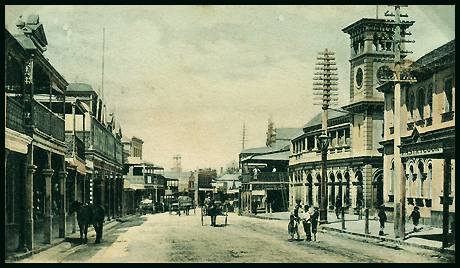 |
|
Personnel: 1869: Mr. W. T. Lee was appointed Telegraph Station Master at West Maitland. It is unclear when he was appointed. July 1871: Mr. A. G. Robins appointed Station Master. June 1875: Mr. Charles H. Caspersonn was appointed Station Master at West Maitland to replace Mr. Morgan. August 1880: Mr. Albert Dunn was a messenger (see above). |
Maitland was one of the 29 Telegraph Offices included in the special printings of delivery envelope NC-EO-3. These envelopes incorporated an embossed oval seal (EO6-ET) on the flap of the envelope with NEW SOUTH WALES at the top and ELECTRIC TELEGRAPH at the base. The office name was embossed across the centre of the seal.
|
|
A steel circular TELEGRAPHS date stamp (SC1-T) was used at the two offices in three formats:
|
Magnification shows the letter following WEST is an M and the letter at lower right appears to be a D. |
|
|
|
| Morpeth.
The Sydney Morning Herald of 7 June 1860 carried the following: "Notice is hereby given, that the Electric Telegraph Office at Morpeth is now open for the receipt and transmission of Messages, in accordance with the authorised rates and regulations". Sydney, 2nd June, 1860. As was usual, that office was in conjunction with another - maybe the Court House or a store. The Telegraph Office combined with the Post Office on 1 January 1870. The Post Office had opened in Morpeth on 1 August 1838. Morpeth is discussed in both the Northern Line and the North-east lines. |
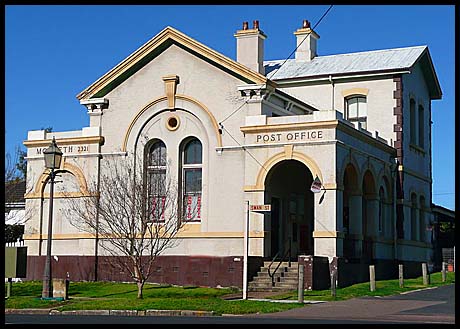 Morpeth P&T office about 2008. Source: Wikipedia. |
|
More telegraph offices were constructed over the years:
As an aside, Morpeth is a special place in Australia for another non-telegraph related development. It is the home of the famous Arnott's Biscuits. The bakehouse in Morpeth was built in 1847 BtTBtT = Before the Telegraph Personnel: May 1867: Mr John Wisdom, late Telegraph Station Master at Morpeth, has been appointed landing-waiter at that port to replace the late Mr. Campbell. May 1867: Mr James E. Ballard, Messenger at Morpeth was transferred to Tamworth to be Junior Operator. June 1867: Mr Dalway Bell was appointed Telegraph Station Master. 1 January 1872: Mr. J. C. Nealds was appointed Junior Operator; April 1872: Mr. C. T. Wakely was appointed Junior Electric Telegraph Operator; |
||
| Murrurundi.
The Telegraph Office opened on 12 June 1861 - apparently in the local Hospital!! It merged with the Post Office on 1 January 1870 but separated again in the following year (on 15 June 1871) only to combine again on 16 December 1888. The Post Office had first opened on 11 May 1837. |
|
|
|
The Empire of 17 May 1861 reported on "a large public meeting held in this town on the 7th instant, for the purpose of representing to the Government the desirability of establishing an electric telegraph station at Murrurundi. A resolution was passed at this meeting, empowering the chairman. Mr. Wright, J P., to communicate with the Government on the subject. As, however, a sum of money has already been voted by the Assembly for the establishment of a station here, and as the size, population and peculiarly important position of this district would preclude the possibility of our being overlooked by the authorities, I think that our friends here need not trouble themselves about the matter. Considerable dissatisfaction has been felt in this neighbourhood at certain statements made by the residents of Scone, in a petition presented by them to the Government, praying for the establishment of a telegraph office at that town. This petition does certainly treat us rather casually and contains two or three extraordinary statements which probably would not stand the test of examination. It would have been more courteous if the Scone folks had, while blowing their own trumpet, omitted to sound their bellicose notes of Murrurundi. The Government too had better look out or, if we may take the tenor of the first resolution adopted at their meeting as a guide, Scone will shortly be calling for a separation from the do-nothing and effete colony of New South Wales". On 7 June 1862, the Sydney Morning Herald reported that the Government had announced "the plans for a telegraph office at Murrurrundi were not yet ready". In the same issue, the Herald reported on a Parliamentary question as follows:
A first tender in July 1862 called for the erection of a single building at Murrurundi containing both a Telegraph and a Post Office The combination was a new policy adopted by the Government. A new tender advertisement to complete the Telegraph and Post Office was advertised in the Sydney Morning Herald on 16 November 1863. In July 1868, tenders were invited for fencing and furnishing to the Telegraph Station at Murrurundi. The floods of 1870 also hit Murrurundi hard: "A fearful flood has occurred here which reached a high point on Sunday morning at one o'clock. Mr Newman, solicitor, abandoned his house on Saturday night. Dr. Richards and family took refuge at Dr Gordon's, whose house was far above the highest flood ever known. At two o'clock, Dr. Gordon and seven children were hunted out in their night-dresses with Dr Richards's family; the wind howling, the water roaring and the screaming of people caused a fearful scene. Mr. Newman has lost everything; some of his furniture was picked up miles away, destroyed; Mr Britton, his wife and thirteen persons were on the roofs of their houses all night, the water within four feet of them. The bridges and culverts are swept away and, if the floods continue, the Telegraph Office and house and half the town must go. We are all in trouble and misery. This is a fearful catastrophe and a loss to this place" (Queanbeyan Age 5 May 1870). In October 1870, £600 was placed on the Estimates for a Telegraph Office at Murrurundi. Possibly before that Office was opened, the Murrurundi Telegraph Office suffered a serious line problem which could not be repaired for several hours. The immediate consequence of this interruption was that the first "Colony of Origin" Chess Match between the Telegraph Offices in New South Wales and Queensland was suspended with plans to resume a few days later. |
|
|
|
"Mr. Lackey in reply to Mr. Fremlin (Legislative Assembly 26 Setember 1882), stated that at the Telegraph Office at Murrurundi there were employed one station master at £200 per annum, one operator at £150 per annum, one operator at £104 per annum, one line repairer at £150 per annum, one messenger at £26 per annum. The average revenue per week for the past six months was £3 13s 1d. The officials employed at Murrurundi were in excess of the usual number at places of equal importance. As the office was open till ten o'clock and a large amount of repeated business passes through Murrurundi for cross stations, rendered it necessary that constant attention should be given to the instrument". Personnel. While the Telegraph Office was still at the Hospital, Mr. Reed was appointed Station Master and Line Repairer at Murrurundi. It was a tough gig but the township people loved him and applauded his efforts. See the Maitland Mercury report of 10 December 1861. April 1865: Mr. John Tierney was appointed Junior Operator. July 1871: Mr. C. N. Ambrose appointed as Electric Telegraph Station Master. August 1871: Mr. Norbert Ambrose was appointed Junior Operator. April 1873: Mr. C. W. J. Chandler was appointed as Junior Operator. July 1877: Mr. Edward H. J. Coleman, a Junior Operator at Murrurundi was transferred to Tenterfield. |
|
Murrurundi was one of the 29 Telegraph Offices included in the special printings of delivery envelope NC-EO-3. These envelopes incorporated an embossed oval seal (EO6-ET) on the flap of the envelope with NEW SOUTH WALES at the top and ELECTRIC TELEGRAPH at the base. The office name was embossed across the centre of the seal.
|
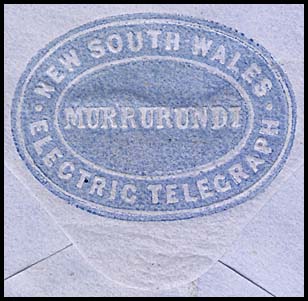 Scan of embossed oval on flap of envelope. Provenance: De La Rue Archives, Gundersen, Johnstone. |
Murrurundi Railway Station. A Telegraph Station was also opened at the Murrurundi Railway Station with a change of name from Haydonton Telegraph Office on 1 October 1896. This office was closed in 1926. |
Muswellbrook was one of the 29 Telegraph Offices included in the special printings of delivery envelope NC-EO-3. These envelopes incorporated an embossed oval seal (EO6-ET) on the flap of the envelope with NEW SOUTH WALES at the top and ELECTRIC TELEGRAPH at the base. The office name was embossed across the centre of the seal.
|
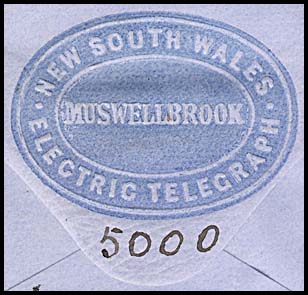 Scan of embossed oval on flap of envelope. Provenance: De La Rue Archives, Gundersen, Johnstone. |
| A Telegraph Office was also opened at the Muswellbrook Railway on 14 September 1894 (a long time after the railway had commenced operation there in 1869). This office was closed at a now unknown date but it reopened on 1 September 1928. The Telegraph Office at the railway station was finally closed on 31 May 1966. |
Personnel: Probably 1860 (say): Mr. John C. J. Smith joined the service and had been the first operator in Newcastle when the public telegraph office was located in the old railway station. In his long career in the Telegraph service, John had been in charge of the Post and Telegraph Office at Wollombi for 28 years until, in August 1903, he was transferred to Braidwood. On 28 December 1865, Mr Watson (Telegraph Station Master) with his wife, children and brother-in-law, were driving on the Wollombi Road to Maitland about 3½ miles on the Maitland side of Cessnock. They were stuck-up by William White alias Yellow Billy and robbed. 18 May 1866: Mr. Watson, Telegraph Station-Master, Newcastle, was appointed Station Master at Wollombi;
July 1871: Mr. W. H. McGuire appointed Station Master. |
Newcastle was one of the 29 Telegraph Offices included in the special printings of delivery envelope NC-EO-3. These envelopes incorporated an embossed oval seal (EO6-ET) on the flap of the envelope with NEW SOUTH WALES at the top and ELECTRIC TELEGRAPH at the base. The office name was embossed across the centre of the seal.
|
 Scan of embossed oval on flap of envelope. Provenance: De La Rue Archives, Gundersen, Johnstone. |
Telegraph Offices were also opened at:
|
A rubber oval date stamp - unrecorded before June 2022 - was used at Newcastle:
Inscription at the top: "NEW SOUTH WALES". |
 24 September 1895. Used on NC-DO-10Ba. |
|
| Basic postal datestamp for Newcastle. Used on telegram delivery forms and would have been used to cancel stamps affixed to transmission forms to prepay telegram costs (although never seen).
Ordinary type 2A date stamp - |
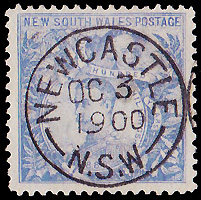 3 October 1900. |
|
Four formats for date stamps were issued to the Newcastle Post and Telegraph Office for use with telegraphic matters:
|
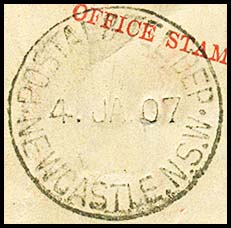 4 January 1907. Used on NI-DO-5A. |
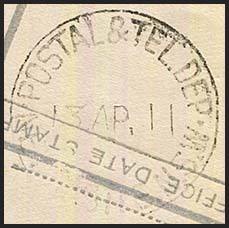 13 April 1911. Used on NI-DO-6A. |
|
|
|
|
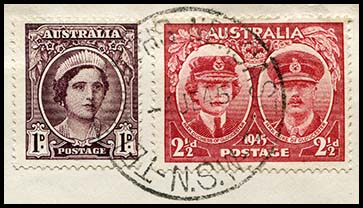 4 June 1945. |
|
|
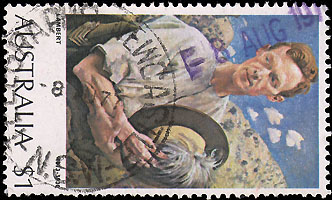 8 June 1977. |
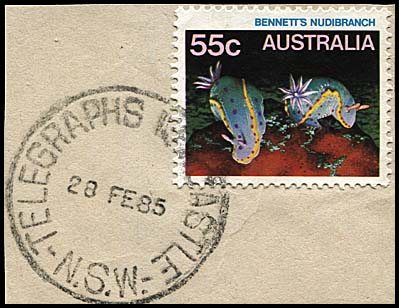 28 February 1985. |
|
|
Five TELEGRAM slogan cancellations are recorded as having been used at Newcastle:
|
|
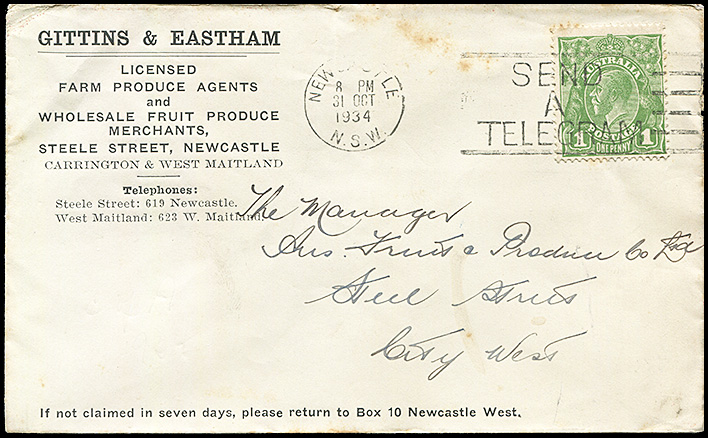 |
SEND A TELEGRAM slogan cancellation.
Used at Newcastle 31 October 1934. Earliest recorded slogan at Newcastle. Circular date stamp with |
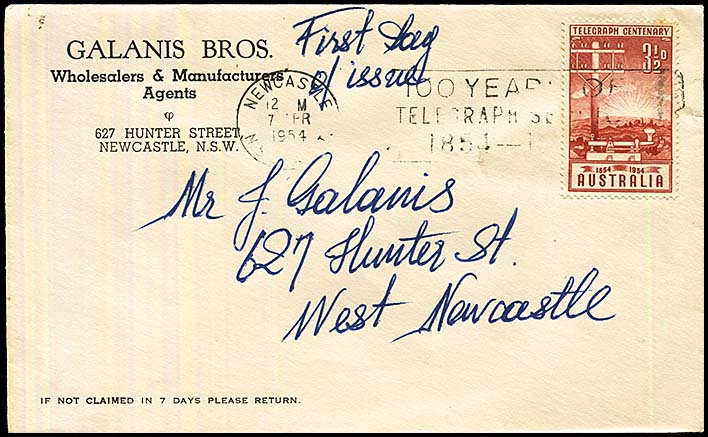 |
100 Years of Used at Newcastle: 7 April 1954. Die 1. Only recorded example of this slogan used at Newcastle. Circular date stamp with |
| Newcastle West.
A Telegraph Office was opened at Newcastle West on 29 August 1889 and became a P&TO on 6 September 1889. |
|
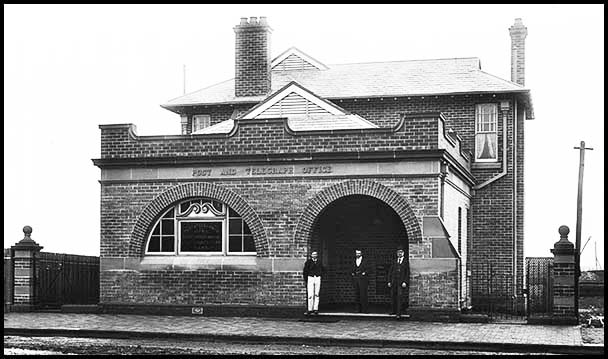 Newcastle West Post & Telegraph Office in 1889-1890 (soon after opening). |
|
The Office was issued with a rubber circular TELEGRAPHS date stamp (RC1 - T):
|
Used on AO-DF-56. |
| Scone.
Even though the Northern line of Telegraphs had passed through Scone in early 1860, no provision had been made for a Telegraph Office there. In the Legislative Assembly of 16 December 1861, there was discussion as to whether Scone should have a separate Station Master (which was being discussed given a second line of wire was also on the Estimates). "Mr. Dangar contended that the population of Scone was quite as great as Muswellbrook. Scone had not troubled the Government much; they had only got £400 for a lockup and £400 for a bridge; but that was only to improve the property of the Secretary of Lands to make passage to his mansion and was of no public advantage to the district. Mr Arnold replied that he did not know whether the hon. Member was in favour or against the vote. From what the hon. Member had said, it would appear that Scone had had more than its fair share of expenditure through some corruption". The Scone Telegraph Office opened on 10 May 1862 and messages transmitted between Scone and Muswellbrook using Wheatston's alphabetical instruments. The Telegraph Office and the Post Office merged on 31 December 1870. The Scone Post Office was established on 1 January 1839 when the Post Office at Invermein (8 km from Scone), which had opened on 1 January 1833, was relocated to Scone and the name changed. Mails were exchanged between Scone, Muswellbrook and Singleton by coach. |
||
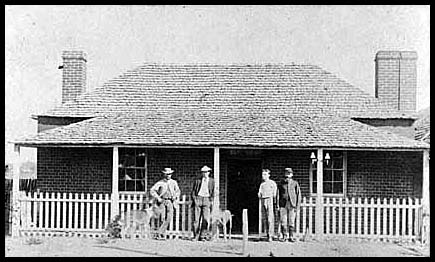 Scone Post Office in 1872. Probably also housed the Telegraph Office. Source: NLA C4076 HN142B |
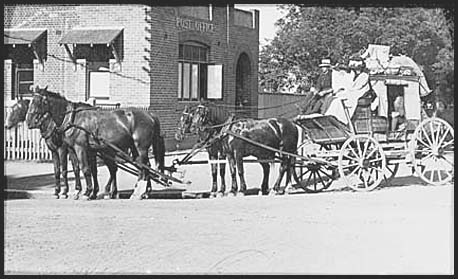 Mail coach outside the Post Office about 1905. Mail coach outside the Post Office about 1905. |
|
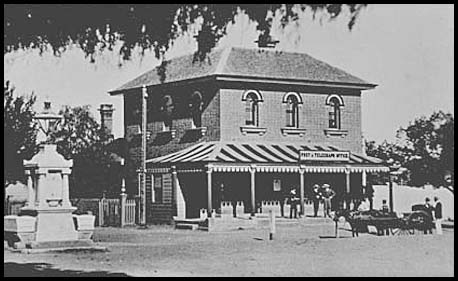 Scone P&T Office - after the renovations - about 1910. Shows the Commonwealth Memorial Fountain. |
||
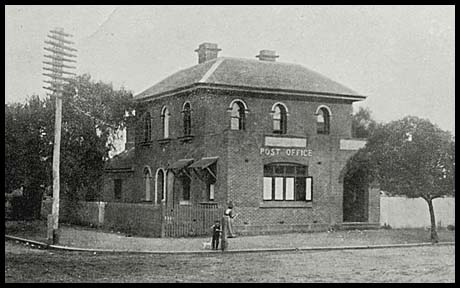 Scone P&T Office - new building - about 1905. |
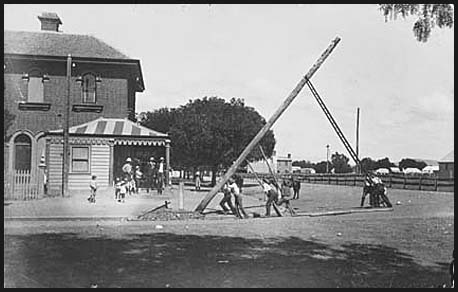 Erecting the telegraph pole outside the Post & Telegraph Office, 1908. |
|
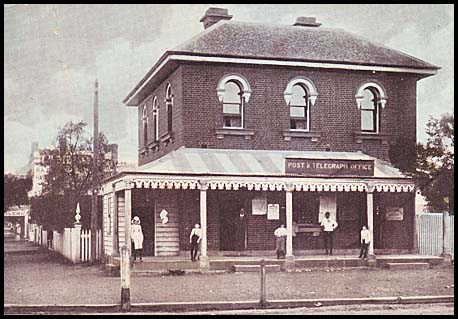 Scone P&T Office about 1910 - detail. |
||
The Maitland Mercury of 9 May 1861 reported on "a public meeting of the inhabitants of the district held at the Police Office, Scone, on the 3rd instant, to consider the steps necessary to be taken to secure an electric telegraph station in this district ... when the estimates of the public expenditure were printed, the intention of the Executive to extend the electric telegraph from Maitland to Queensland included provision for stations at Singleton, Muscle Brook, Murrurundi, Tamworth, Armidale, etc., but Scone was left out". The account of the meeting and the disdain offered to the people of Scone can be read elsewhere. An interesting interchange reflecting social and economic condisions of the time occurred in the Legislative Assembly on 14 August 1864: "Mr. Dangar said he never expected that the telegraphs or the railways, would be at first paying oonoerns but they were constructed for the benefit of the public, and were no doubt of immense advantage to the country. He drew attention to the low salary of £25, which had been received during the last two years by the officer at Scone. He did not see why this young man should not be paid a salary equal to the salaries paid to the other twenty-four officers. He took the office on condition that he should be promoted and he had, for the last two years, attended at the office from nine in the morning till six in the evening. Mr. Holroyd said the hon. member for Scone had put rather a glowing face on the matter to which he had referred. This obscure place called Scone had but a very limited telegraphic correspondence. ('Oh, oh," and laughter). This young gentleman was appointed on the hon. member's own recommendation. His father was postmaster - the telegraphic instrument was on the postmaster's premises and this young gentleman devoted a portion of his time assisting his father in the store. The working expenses of this station were very little more than the salary paid. It was the intention of the Superintendent of Telegraphs to remove this young gentleman at no distant period. The hon. member's protege was not forgotten". A new combined office was planned and tenders accepted in 1878. |
||
Personnel: January 1863: Mr. A. E. Middleton appointed Junior Clerk. January 1863: Mr. S. G. Watson, the Station Master, was transferred to Sydney. September 1876: Mr. Joseph Kelf was promoted from Booking Clerk in Head Office to Post and Telegraph Master. July 1901: Mr. J. G. Elliott, the newly-appointed Singleton Postmaster, had been postmaster at Deniliquin for 11 years. He was the recipient of a handsome illuminated address and purse of 40 sovereigns prior to his departure from that town. He also received a presentation from the Post and Telegraph staffs. Mr. Elliott enjoyed a holiday prior to taking charge at Singleton. |
Singleton was one of the 29 Telegraph Offices included in the special printings of delivery envelope NC-EO-3. These envelopes incorporated an embossed oval seal (EO6-ET) on the flap of the envelope with NEW SOUTH WALES at the top and ELECTRIC TELEGRAPH at the base. The office name was embossed across the centre of the seal.
|
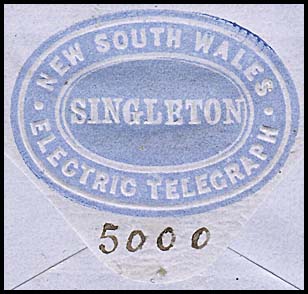 Scan of embossed oval on flap of envelope. Provenance: De La Rue Archives, Gundersen, Johnstone. |
| A Telegraph Office was also opened at Singleton Railway Station in 1883. That office closed on 30 November 1967. It used a type 3(i) datestamp of SINGLETON RAIL. |
|
The first Tamworth Post Office had opened on 1 January 1840. The line of telegraph to Tamworth was opened for the transmission of messages at 8 p.m. on 10 October 1861 "after the receipt of a congratulatory message from the Secretary of Public Works". That was about a day after the Telegraph Office in Stawell, Vic (for those who like random facts). A temporary office was used pro tem. Tamworth is discussed in both the Northern Line and the North Central lines.
1. The first Tamworth Telegraph Office. On 14 September 1861, the Tamworth Examiner revealed two important developments: "During the past week the instruments necessary for opening the telegraph arrived in town and were deposited in the Court House. We have not heard where the office is to be situated, but we trust that it will be in a central part of the township. The apparatus, we learn from the reply of Mr. Arnold to a question put by Mr. Hoskins in the Assembly, has been on the road between Maitland and Tamworth since June last - three months. The delay in their arrival has been set down to the floods account. But will any one presume to say - if we except Mr. Arnold - that the roads have been in such a state as to prevent drays travelling during the past three months? The statement is simply preposterous. Scores of drays with goods have passed through Tamworth which were loaded six or eight weeks subsequent to that on which the dray with these instruments were despatched and they are now on their way back to Maitland". The Tamworth Examiner of 11 October 1861 reported on the opening of the Telegraph Office: "On Wednesday (9 October) Mr. Cracknell, Inspector of Telegraphs, arrived in Tamworth and proceeded at once to erect the necessary apparatus for working the line and by four o'clock in the afternoon of that day, messages were transmitted to Sydney but this could not be done without repeating at Murrurundi. On Thursday, however, messages were sent through from Tamworth to the metropolis and the line is now open to the public. The charges are: for ten words or under, 4d.; and for every additional word 3d. Mr Cracknell proceeded on to Armidale to open the line there and will go from thence to Glen Innes and Tenterfield where offices are also to be established. The line from Brisbane (Queensland) to the frontier of the colony will in all probability be completed by the time the Inspector reaches Maryland, so that we may anticipate communication with the sister colony in a fortnight or three weeks hence".
2. Early operation of the line through Tamworth. The Tamworth Examiner of 11 December 1861 commented two months after the line was opened: "It is nearly time the attention of the Government was drawn to the very unsatisfactory working of the telegraph in the Northern districts. The line to Tamworth was opened on the 12th of October last, after an unnecessary delay of some three months but, since then, it has for all practical purposes been of little or no service to the public. Since the day it was opened, it has not been a week continuously in working order, indeed we might say it has not been three days without some interruption taking place. Either a "storm at Sydney" or "a tree across the line" has been the almost invariable reply we have received when we applied for our messages. So frequent have interruptions become that we have given up all dependence on the receipt of any intelligence by this means for, if the line is not down between Tamworth and Sydney, it is sure to be interrupted between here and Armidale and as the station-master here is also line inspector, he has to start off to repair the damage, and of course no communication can be had during his absence. But last week put a climax to the annoyance which has been going on for some time - the clerk here being absent from the office four days out of the six repairing the line! First it was down at Wallabadah, then at Carlisle Gully, again on the Wallabadah road. As the distance to be travelled on either side is some thirty-five miles, the journey takes fully a day, not to mention the time occupied in repairs. If this is to be altered, the Government must appoint a line inspector, as it is impossible for the duties of station-master and line inspector to be combined, where the distance between the stations is so great". 3. Need for a proper Telegraph Office. The Sydney Morning Herald of 26 August 1863 alluded to the lack of a permanent Telegraph Office as follows: "This township has been partially flooded during the present week — the temporary office for telegraph was surrounded by water. Strange that tenders were not calledPerhaps a sense of despair when it was less than two years since the telegraph line had been connected to Tamworth. for the erection of a Post and Telegraph Office in this town. Now that the site has been duly transferred to the Government there are no just grounds for delay". The Telegraph Office - wherever it had been opened - was very noticeable in May 1864 during the Queen's Birthday celebrations: "Here in Tamworth, although perhaps less demonstrative than at other places, the people celebrated the holiday nevertheless in as enthusiastic a way as circumstances would permit of. A cricket match was played on the banks of the river between rival teams of married and single men. There was a pretty good muster of the townspeople, and Mr. Settatree had a booth on the ground well stocked with refreshments. The match was for a lunch and was won by the single men. In the evening the usual quantity of fireworks were discharged and the sport in this way kept up until a late hour. We noticed only one place in the town illuminated - namely the telegraph office - which formed a pleasing contrast to the other buildings in the neighbourhood". On 9 December 1865, the Tamworth Examiner commented on the new Telegraph Office as follows: "We omitted to mention a week or two ago that the contractors for our new Telegraph and Post Office — Messrs Brown and Grace — have completed their work and the new building now only awaits the arrival of the Government Inspector in order to hand it over. The building is very substantial, but like nearly every Government erection, it has a peculiar design of its own. It would not be difficult for a person to go into any town in the colony and point out every Government building in it. About the whole of them there is the same dreary waste of brick—heavy, massive, and lubberly; there seems to be no desire to please the eye. So long as they are substantial, nothing more appears to be desired". The Telegraph Office merged -for a short while - with the Post Office on 8 October 1870(??). In 1876, the Superintendent of Telegraphs (Mr. E. C. Cracknell) recommended splitting the Tamworth Post and Telegraph offices. The ensuing alleged corruption created an interesting debate (p.3) in the Legislative Council. Another Telegraph Office was opened 2 km. away at West Tamworth on 21 February 1879 - the same day on which a Post Office was also opened in the same building. The two offices were independent. |
||
|
||
| 4. A second Telegraph Office.
Complicating the Tamworth situation further, the Sydney Morning Herald for 17 March 1880 reported on a public meeting held the previous day in Tamworth "respecting our present Post and Telegraph Office. The Mayor presided and the following resolutions were unanimously carried:
On 18 October 1881, the Australian Town and Country Journal reported that "A rumour is current in Tamworth that only £3,500 will be voted for the new Post and Telegraph Offices. There is much dissatisfaction as the amount is not considered enough for the importance of the town and district". Tamworth was first to install electric street lights in Australia - in 1888. |
||
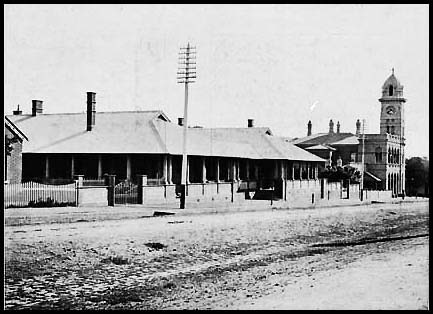 Tamworth P&T Office about 1900. Tamworth P&T Office about 1900.
|
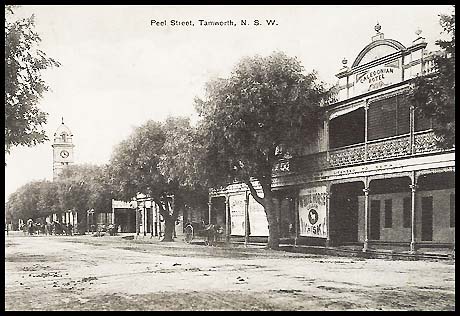 Peel Street, Tamworth looking towards the Post Office. |
|
|
3 August 1860: Mr. Arnold Elliott was announced as the junior operator of the Electric Telegraph Station at Tamworth - about two months before the connection was made. 6 February 1864: "We have this week to announce the very sudden death of Mr. James Mackel, formerly Telegraph Station Master at Tamworth. It appears that the deceased had been suspended for misconduct of some kind or other, and his case was under consideration when his death occurred. While under suspension, he had taken to drink very heavily and its effects were becoming apparent, although naturally of robust frame. On Sunday evening last he returned to his lodgings at Mr. Fitzpatrick's accommodation house and seemed the worse for liquor. He then retired to bed and, on the following morning, was found a corpse having died during the night, without, however, having disturbed any of the inmates of the house in his last struggles. A magisterial enquiry was held by the Police Magistrate and the above facts elicited". April 1865: Mr. James K. Craig was appointed Junior Operator. May 1867: Mr James H. Craig, Junior Operator at Tamworth was transferred to Penrith to be Junior Operator.
23 January 1869: Mr. T. W. Parrot was appointed overseer of the repairs to the telegraph line from Tamworth to Narrabri. 5 June 1869: Mr. Ballard, messenger at the Tamworth Telegraph Office telegraph office left Tamworth for the Narrabri to perform the duties of acting-telegraph master until the Government appointed someone to the position permanently. April 1872: Mr. Charles Chapple was appointed as a Junior Operator at Tamworth. July 1876: Mr. Edward Parsons, Junior Operator at Tamworth, was promoted to be Station Master at Bendemeer to replace Mr. Culnane who had resigned.
|
||
|
The earliest indication of the operation of the Tamworth Telegraph Office is delivery form NC-DO-7Aa used on 19 December 1879 - about 18 years after opening. |
||
| 7. Tamworth date stamps.
A steel circular type 2C
|
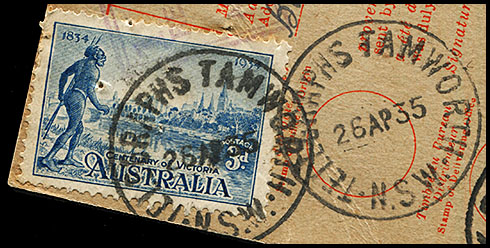 26 April 1935. On a receipt for Registration. |
|
|
||
|
||
The same date stamp was used but with TELEGRAPHS removed:
|
||
| Tamworth also used the usual postal date stamps on telegrams.
The example shown at the right is a very early use of a postal date stamp on a telegram.
|
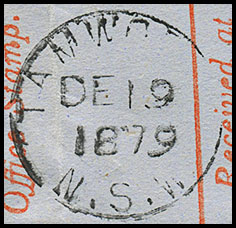 19 December 1879. Used on NC-DO-7Aa. |
|
| Later the postal date stamp then current was used to record the received date on telegrams. | ||
| Tenterfield.
Given that Tenterfield was the site for the inter-colonial connection, it is surprising that no Telegraph Office was ever opened for the public in Tenterfield. The Office was the repeating station between New South Wales and Queensland. The opening date for the operational use of the Telegraph Office was 8 November 1861. At first, it was staffed mainly by Queensland officers. The Post Office had opened in Tenterfield on 1 January 1849. Tenterfield is discussed in both the Northern Line and the North-east lines. |
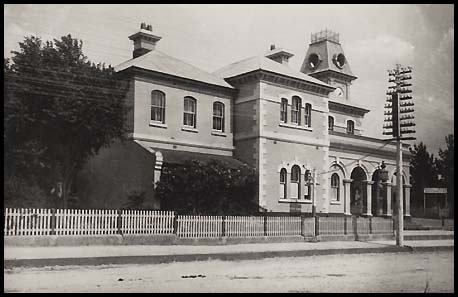 Tenterfield Post Office. The building was first established in 1881. Tenterfield Post Office. The building was first established in 1881.It is now on the Register of the National Estate. |
|
In the Gazette of 6 August 1863: Completing Building
for Electric Telegraph Office, Tenterfield. Tenders will be received at this office, until twelve o'clock on Tuesday, the 1st September next, from persons willing to contract for the completion of building for Electric Telegraph Office at Tenterfield. Tenders to be endorsed "Tender for completion of building for Electric Telegraph Office, Tenterfield." Plan, specification, and form of tender may be seen, and further particulars obtained, at the Colonial Architect's Office, Sydney, and at the Police Office, Tenterfield". During a thunderstorm in November 1872, several articles in the telegraph office were set on fire by lightning. In answer to a question in the Legislative Assembly of 1 February 1878, it was stated that "Revised plans were being prepared for new Post and Telegraph offices at Tenterfield and tenders for the work would be called for as soon as possible". A turret clock costing £300 was installed in the Post & Telegraph Office in 1890. Sir Henry Parkes delivered his famous Federation Speech in Tenterfield on 24 October 1889. It is claimed that this speech re-opened the discussion which led to Australia's Federation in 1901. 1. Personnel: January 1863: Mr. Michael W. Jordan was appointed Line Inspector. November 1868: Mr. Charles J. Muston was appointed Telegraph Line repairer. March 1872: Mr. John Isaac was appointed Telegraph Line Repairer. April 1873: Mr. C. W. Ambrose was appointed to be an Operator. June 1875: Mr. James L. Webster was appointed as Automatic Operator. June 1875: Miss Mary Louisa Bailiff was appointed as an Operator. August 1875: Miss Lizzie A. Lardner, to be Automatic Perforator. October 1876: Mr Walter Tomkinson, a junior telegraph operator at Mount Victoria, was transferred to Tenterfield as a Telegraph Operator to replace Mr. Aubin who had been promoted.. July 1877: Mr. Edward H. J. Coleman, a Junior Operator at Murrurundi was transferred to be a Junior Operator at Tenterfield. |
||
| Tenterfield Railway Station.
A Telegraph Office opened at the Railway Station sometime after October 1884 and closed on 31 March 1961. A steel circular TENTERFIELD RAILWAY type 2C date stamp was issued to the office:
|
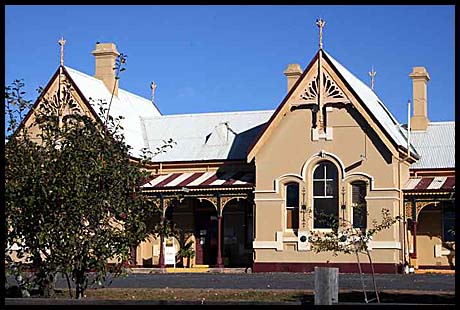 Tenterfield Railway Station where a Telegraph Office operated until 1961. |
|
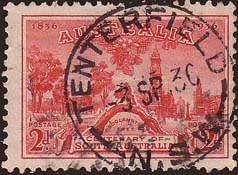 Type 2A datestamp with side arcs but no full stop after W. |
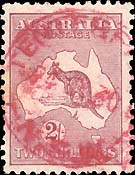 Type 2A datestamp with side arcs but no full stop after W. Printed in red ink on 2/- Roo which was a common high value rate on telegrams. |
|
|
|
|
Personnel: January 1868: Mr. Donald Graham was appointed Station Master. December 1874: Mr. James Falconer was appointed Station Master. |
Uralla was one of the 29 Telegraph Offices included in the special printings of delivery envelope NC-EO-3. These envelopes incorporated an embossed oval seal (EO6-ET) on the flap of the envelope with NEW SOUTH WALES at the top and ELECTRIC TELEGRAPH at the base. The office name was embossed across the centre of the seal.
|
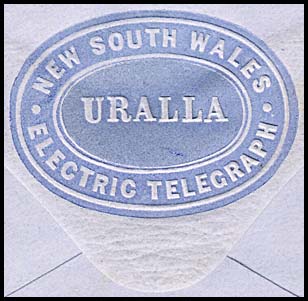 Scan of embossed oval on flap of envelope. Provenance: De La Rue Archives, Gundersen, Johnstone. |
|
The station was opened as a temporary station in 1878 but the present station was opened in 1880 when the main northern line was extended from Quirindi to West Tamworth - see elsewhere. There are no known dates for the operation of the Telegraph Office. |
|
| The Office was issued with three date stamps although only the first had a reference to Telegraph: TELEGRAPH OFFICE WERRIS CK RLY STN.
|
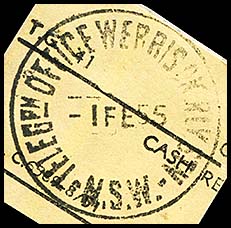 1 February 1955. |
|
The earliest indication of the operation of the Windsor Telegraph Office is delivery form NC-DO-2 used on 13 October 1870 - about 18 years after opening. |
| The next earliest recorded Windsor telegram form is NC-DO-7Aa on 15 February 1879. |
| 4. Date stamps.
A rubber oval RO2 date stamp was issued to the Office during the 1890s. The top inscription was simply WINDSOR.
|
|
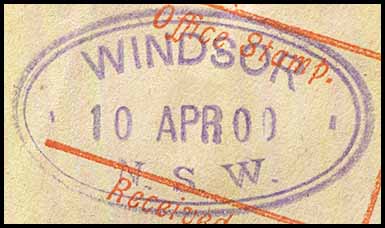 10 April 1900. Used on NC-DO-10B. |
| Circular date stamps.
Side arcs. No stop after W.
|
|
|
Windsor framed for usual postal use.
|
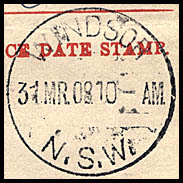 |
|
Post-1917 (Establishment period) Large date with 2 digit year. H&T Type 2A.
|
|
|
Large date with 2 digit year.
|
|
| S traight line handstamp for WINDSOR. |  Windsor straight line hand stamp. 30 June 1897. Used on NC-DO-10A. |
| Wollombi.
The Telegraph Office was opened on 3 March 1860 while the Post Office had opened on 1 January 1839. The two office were combined on 10 July 1882. Tenders (for Wollombi and Windsor) were called in the Gazette of 13 July 1860 for the erection of an Electric Telegraph Station at Wollombi with a closing date of 24 July. The SMH of 22 October 1860 expanded on this announcement: "Several new telegraph stations are in progress or about to be proceeded with, the courthouses having hitherto been used for that purpose in the towns through which the wires have been carried. New stations have been commenced at West Maitland, Newcastle, Windsor, Albury, Goulburn, Bathurst, and Yass and others will soon be put up at Gundagai, Hartley and Wollombi. The buildings are nearly all upon one plan consisting of five rooms including a residence for the station master". The tender submitted for Wollombi was too high and therefore could not be accepted. New tenders were called and these closed for the construction of a new Post and Telegraph Office on 1 June 1892. In 1900, general repairs and renovations were carried out on the Post and Telegraph Office at Wollombi. The buildings were also painted and the roadway at the side was formed to improve the approach to the buildings. In Question Time in the Legislative Assembly on 18 July 1872, in answer to a question "That a horse and buggy had, by Ministerial authority given in 1866, been purchased at the public cost for the telegraph station master at Wollombi and that the expenditure was made under the vote taken for 'repairs generally that a portion of the road from Mulbring to Millfield had been opened from time to time' ". Personnel: February 1866: Mr. R.S. Arnott was Station Master and Line Inspector. 18 May 1869: Mr. Watson, Telegraph Station-Master, Newcastle, has been appointed Station-Master at Wollombi; Mr. Ambrose, of the Windsor station, is to be his successor. June 1875: Mr. John C. J. Smith from Wiseman's Ferry was appointed as Station Master and Line Repairer to replace Mr. S. J. Watson who was promoted. August 1903: Mr. John C. J. Smith (yes - same guy) who had been in charge of the Post and Telegraph Office at Wollombi for 28 years was transferred to Braidwood. John had joined the service over 40 years ago and had been the first operator in Newcastle when the public telegraph office was located in the old railway station. |
||
Early usage: The earliest record of the operation of the Wollombi Telegraph Office is a delivery form (NC-DO-8A) sent from Wollombi to Windsor on 17 February 1887. |
||
Date stamps: No special date stamp was issued to Wollombi for use with telegraphs. The usual steel postal date stamp (SC1) was used instead.
|
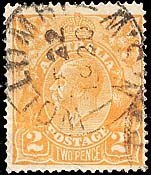 |
|
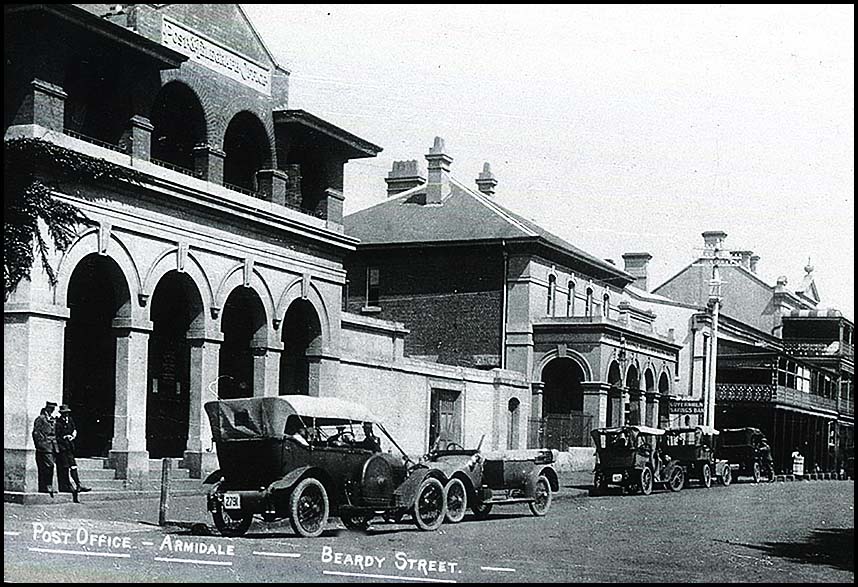
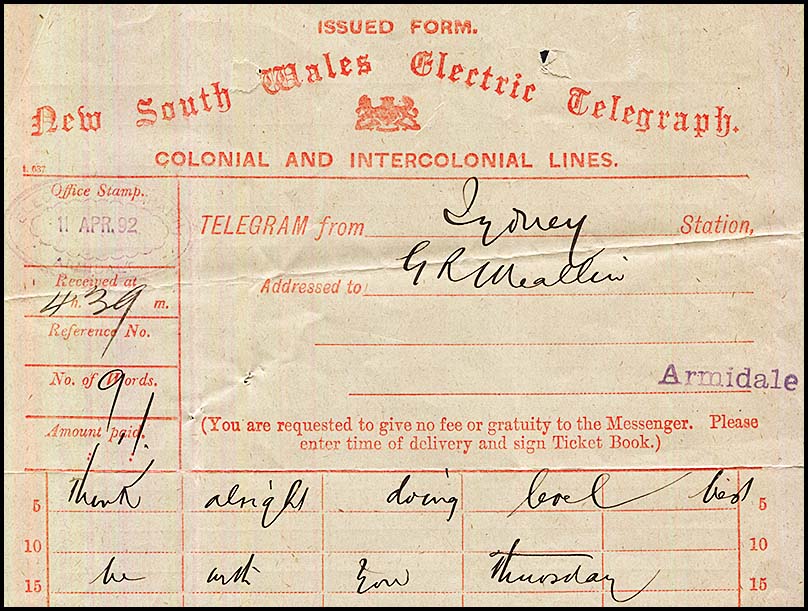
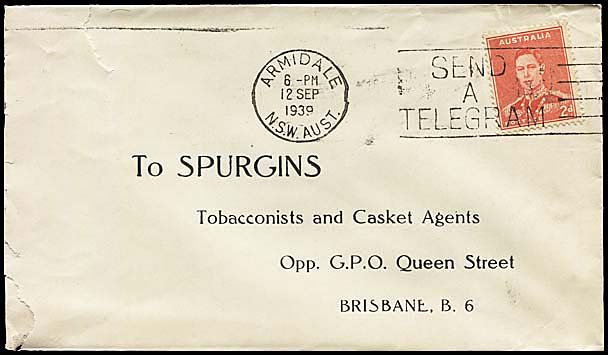

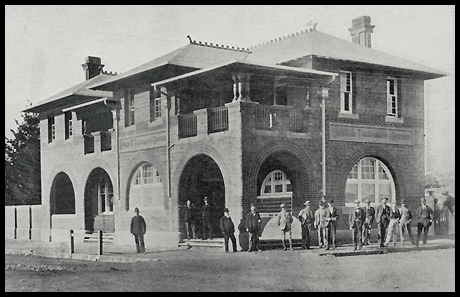
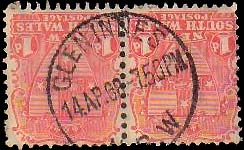
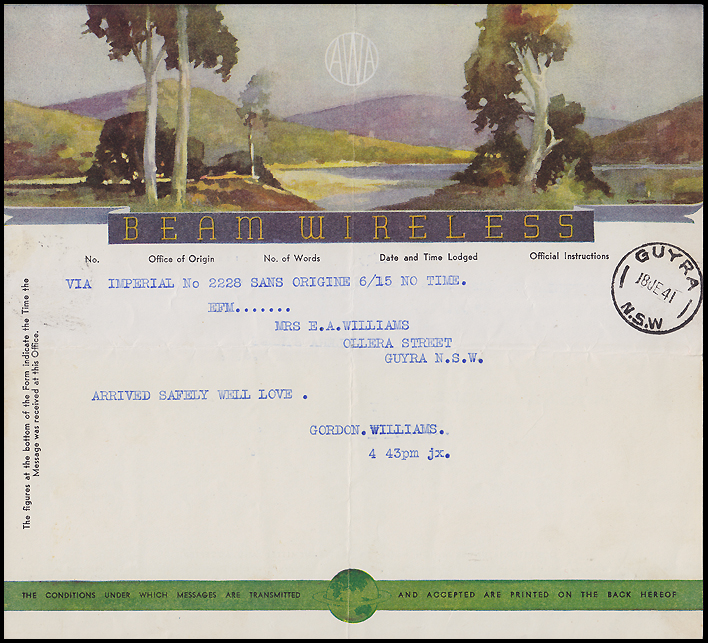
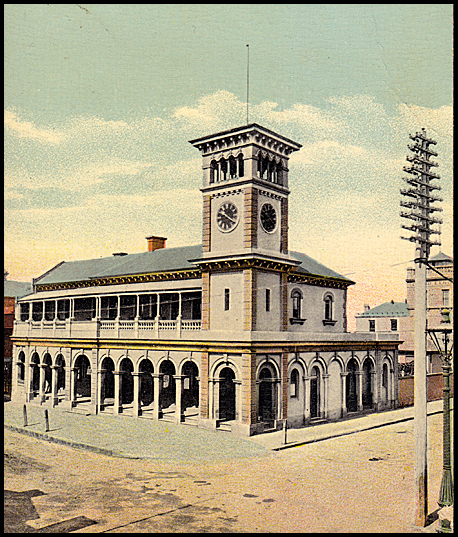
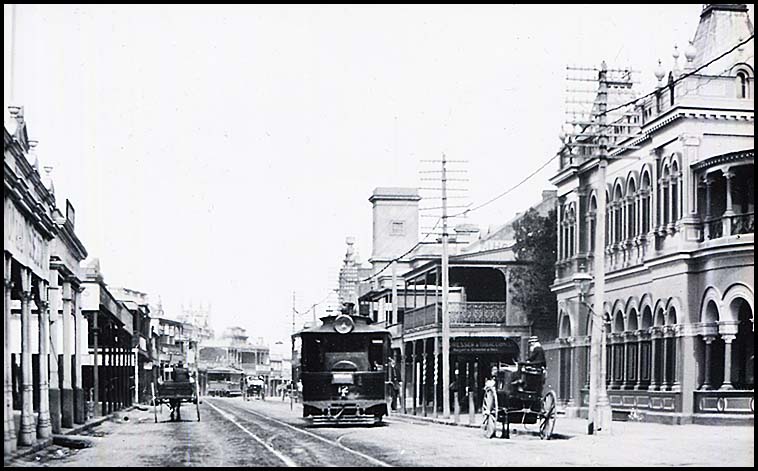
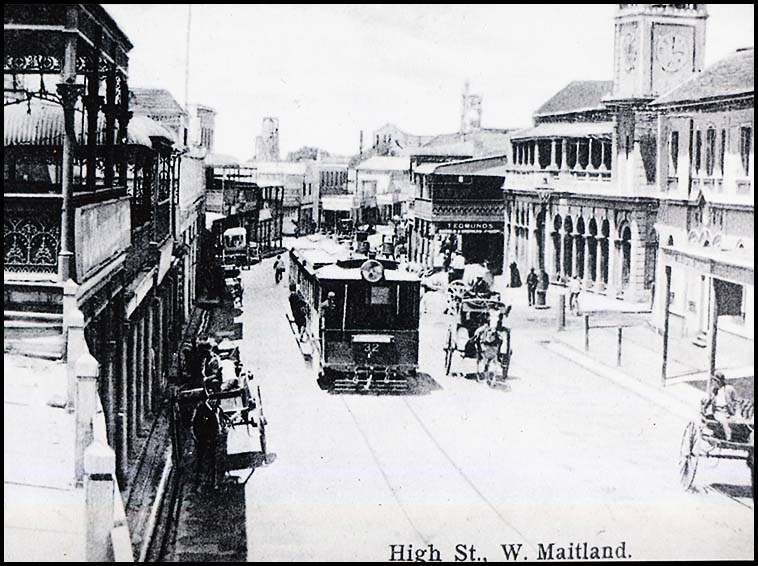

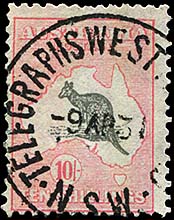
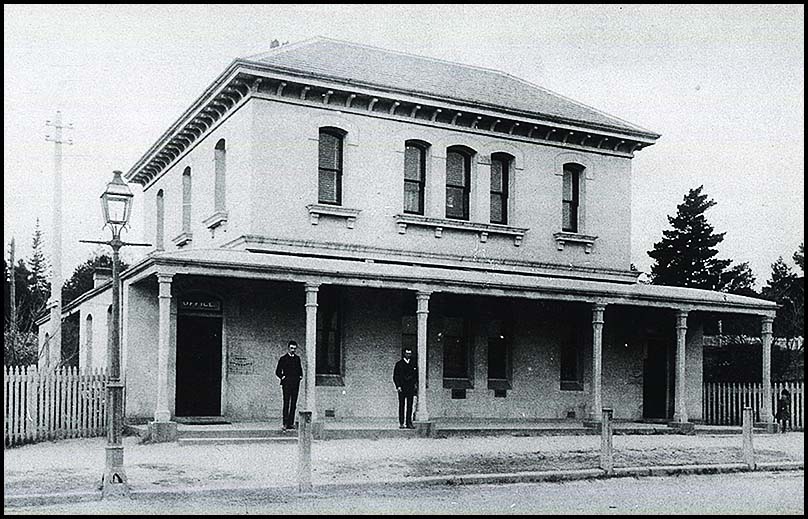 East Maitland Post & Telegraph Office about 1885 -soon after merging.
East Maitland Post & Telegraph Office about 1885 -soon after merging.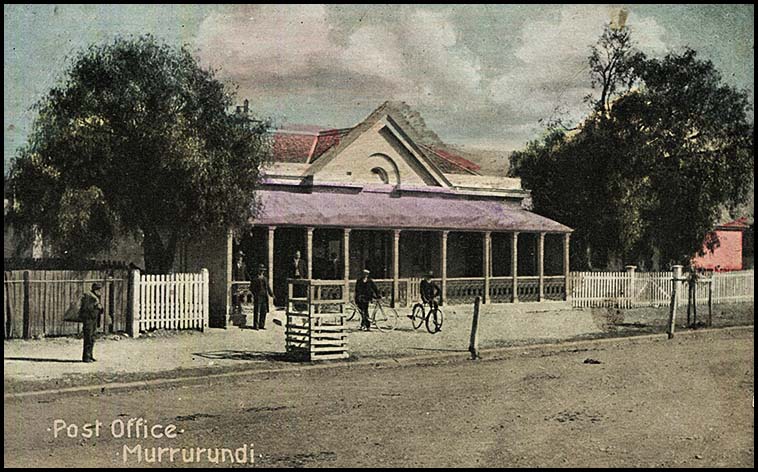
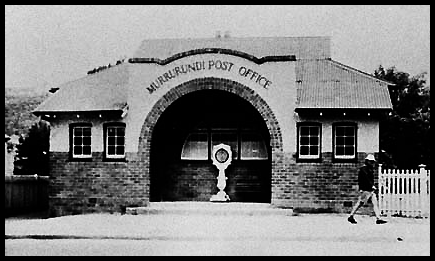
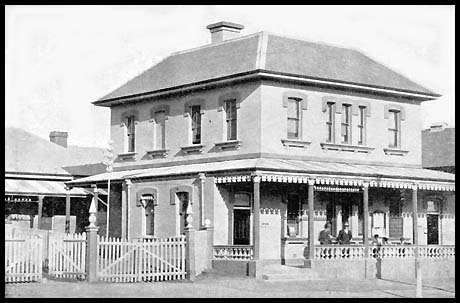
 Newcastle Post & Telegraph Office.
Newcastle Post & Telegraph Office.